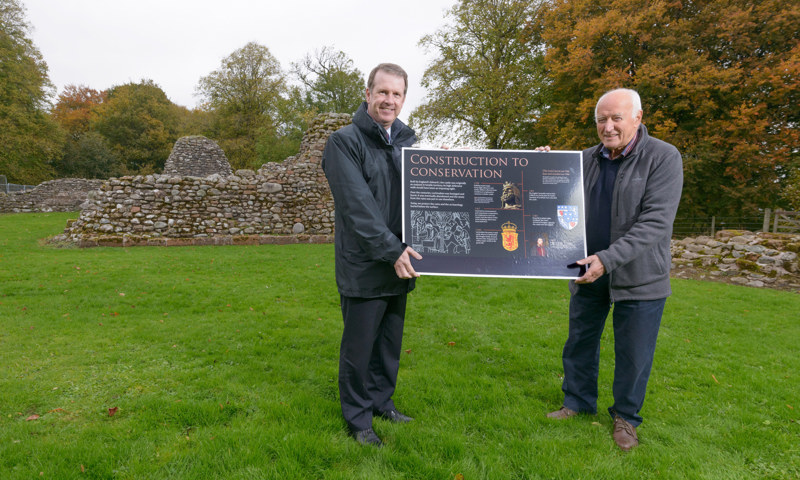New interpretation panels – which tell the story of the castle – have been unveiled at Lochmaben Castle, shedding a spotlight on its past, from its role in the Wars of Independence to a visit by Queen Victoria.
The castle, which now sits in a ruinous state following its abandonment in the 17th century, lost much of its exterior wall facing in the following centuries, as the valuable stonework was used by locals, as was the custom at the time, to create new buildings for the growing burgh of Lochmaben.
This left behind a ruin which has been subject to further interventions over the following centuries, as well as more recently being affected by current issues such as climate change, which have contributed to the current condition of the site.
Now, Historic Environment Scotland (HES) – who manage the castle, and the Castle Loch Lochmaben Community Trust – who have recently taken on the care of the loch and the surrounding area, have come together to look at ways to tell its story to the local community and visitors to the area alike.
This has included shedding light on the condition of the building and repairs made in its more recent history as part of the interpretation of the site, alongside its broader story.
The new series of interpretation panels were unveiled by Alex Paterson, Chief Executive of Historic Environment Scotland and David Rose from the Lochmaben Community Trust, at the castle.

Chief Executive of Historic Environment Scotland, Alex Paterson (left), and Dave Rose from the Castle Loch Lochmaben Community Trust, with one of the new interpretation boards, which have been installed at Lochmaben Castle.
David Rose said: “I’m delighted to be here to reveal the new interpretation panels. I hope visitors to the Castle will find them informative and interesting, and they will assist in understanding not only the site’s rich history but some of the challenges faced in conserving this 700 year old site. The Trust have been very happy to be so involved in this initiative with HES and I hope our organisations can continue to work together positively in the future.”
The panels are the latest in a series of recent initiatives involving Historic Environment Scotland and the community trust to help bring to life the story of the site and to provide opportunities to engage the community with its heritage. In September, an archaeological geophysical survey was carried out at the site to help shed new light on its history and development. A series of events was held at the castle in conjunction with the work, which offered hands-on demonstrations as well as guided tours of the site.
Although the initial results from the survey are still in their infancy it is hoped that they will provide scope for further work and collaborative activities which will help to enhance knowledge and understanding of the site.
Alex Paterson said: “The recent work at Lochmaben is indicative of what can be achieved when communities are enabled to champion and support their heritage.
“There are of course on-going challenges in regards to managing sites such as Lochmaben, but focussing on solutions is key and I am pleased to have had the opportunity to visit the castle and meet with the Trust to see first-hand some of this work.
Our heritage plays a key role in communities as well as providing a number of benefits ranging from educational opportunities to being a catalyst as a tourism driver to name but a few.
“It’s important though to acknowledge that heritage comes in different forms, and each has a different story and contribution to make. Working with communities and partner groups such as the Trust is a key priority for us as Scotland’s lead body for heritage and I’m very encouraged by the recent work at Lochmaben as to what can be delivered.”
A fortress was first established at Lochmaben Castle by the English King Edward I in 1298. This changed hands between England and Scotland numerous times throughout its history, becoming a royal castle of Scotland in the 1440s, nearly 150 years after it had held firm against a five day siege from the Earl of Carrick, who would go on to become King Robert the Bruce.
The panel unveiling comes ahead of a meeting of the Historic Environment Scotland Board in Dumfries, who will be visiting a number of sites such as Caerlaverock Castle and Lochmaben Castle as well as hosting a stakeholder event at Easterbrook Hall.
Historic Environment Scotland was established in October 2015. With a remit ranging from tourism and education to planning and grant funding, the organisation is Dumfries and Galloway’s biggest tourism operator with over 30 historic sites in its care and awarded more than £740,000 of grant funding in the region last year to restore historic buildings and provide economic regeneration, in areas ranging from Stranraer to Annan.
To find out more or to join in the #HESstory please follow us at @HistEnvScot
Notes for editors
- HES care for over 300 historic sites across Scotland which together help tell more than 5,000 years of history. Dumfries and Galloway is home to 30 of sites, including castles, abbeys, a fort and an 18th century mill
- In 2015 more than 74,000 people flocked to Historic Scotland visitor attractions throughout Dumfries and Galloway
- In the past year a total of £704,317 has been invested by HES, including grant funding of £541,392 through the Stranraer Conservation Area Regeneration Scheme, with £411,320 being awarded to the Annandale Distillery.
- HES also supports and works with partners throughout the area. From helping The Whithorn Trust to thatch a roundhouse to working with the Treasure Trove Unit and the Queen’s and Lord Treasurer’s Remembrancer with the conservation of the Galloway Hoard – the largest hoard of Viking treasure to ever have been discovered in Britain
- Dumfries and Galloway is home to 215 listed buildings, 1,023 scheduled monuments, 19 gardens and designed landscapes and 13,809 archaeological sites.
About Historic Environment Scotland (HES)
- We are the lead public body charged with caring for, protecting and promoting the historic environment. We will lead on delivering Scotland’s first strategy for the historic environment, Our Place in Time.
- Historic Scotland is a sub brand of HES.
- View our press pack and keep up to date by registering for media release email alerts. If you wish to unsubscribe, please contact us.
Year of Innovation, Architecture and Design 2016
2016 is the Year of Innovation, Architecture and Design (IAD). Through a series of exciting events and activity, the year will showcase Scotland's position as an "innovation nation", its outstanding built heritage, and its thriving, internationally acclaimed creative industries sector. This is a Scottish Government initiative being led by VisitScotland and supported by a variety of partners.
Follow Historic Environment Scotland
Twitter: @HistEnvScot | @welovehistory
Facebook: @HistoricEnvScotland | @VisitHistoricScotland
For further information, please contact:
Iona Matheson
Historic Environment Scotland Media Office
Direct Line: 0131 668 8703
Mobile: 07827 956 858
iona.matheson@hes.scot


